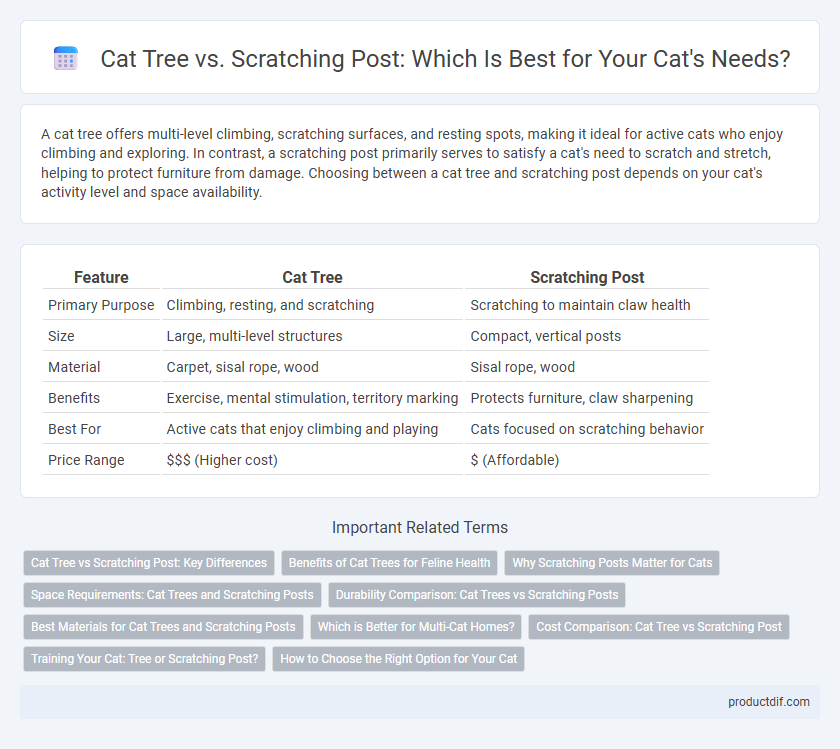A cat tree offers multi-level climbing, scratching surfaces, and resting spots, making it ideal for active cats who enjoy climbing and exploring. In contrast, a scratching post primarily serves to satisfy a cat's need to scratch and stretch, helping to protect furniture from damage. Choosing between a cat tree and scratching post depends on your cat's activity level and space availability.
Table of Comparison
| Feature | Cat Tree | Scratching Post |
|---|---|---|
| Primary Purpose | Climbing, resting, and scratching | Scratching to maintain claw health |
| Size | Large, multi-level structures | Compact, vertical posts |
| Material | Carpet, sisal rope, wood | Sisal rope, wood |
| Benefits | Exercise, mental stimulation, territory marking | Protects furniture, claw sharpening |
| Best For | Active cats that enjoy climbing and playing | Cats focused on scratching behavior |
| Price Range | $$$ (Higher cost) | $ (Affordable) |
Cat Tree vs Scratching Post: Key Differences
Cat trees provide multi-level platforms for climbing, resting, and playing, offering cats vertical space and enriched environmental stimulation, while scratching posts primarily focus on satisfying cats' natural scratching instincts to maintain claw health. Cat trees often combine scratching surfaces with cozy perches, hiding spots, and interactive toys, promoting both physical exercise and mental engagement. Scratching posts tend to be compact and dedicated solely to scratching, making them ideal for limited spaces or targeted claw maintenance.
Benefits of Cat Trees for Feline Health
Cat trees provide multifaceted benefits for feline health by promoting physical exercise, mental stimulation, and stress reduction. Their vertical structures encourage climbing and jumping, enhancing muscular strength and joint flexibility while supporting natural claw-scratching behaviors that maintain nail health. Elevated perches also offer safe observation points, reducing anxiety and improving overall well-being in cats.
Why Scratching Posts Matter for Cats
Scratching posts are essential for cats because they help maintain healthy claws and provide a natural outlet for scratching behavior, which prevents damage to furniture. Cats use scratching posts to mark territory through scent glands in their paws, reinforcing their sense of security. Investing in a sturdy, well-designed scratching post supports feline physical and mental health by encouraging exercise and stress relief.
Space Requirements: Cat Trees and Scratching Posts
Cat trees typically require more space due to their multi-level platforms, perches, and additional features like hiding spots or ramps, making them suitable for larger living areas or dedicated pet zones. Scratching posts, in contrast, have a more compact footprint and can easily fit into smaller spaces, ideal for apartments or rooms with limited floor area. Choosing between the two depends on available space, with cat trees demanding a significant vertical and horizontal area while scratching posts offer a space-efficient alternative.
Durability Comparison: Cat Trees vs Scratching Posts
Cat trees generally offer superior durability compared to scratching posts due to their multi-level construction, reinforced platforms, and use of robust materials like wood and sisal. Scratching posts, while effective for claw maintenance, often wear out faster as they primarily rely on wrapped sisal rope, which can fray with frequent use. Investing in a well-built cat tree provides long-lasting entertainment and resilience, making it a more durable option for active cats.
Best Materials for Cat Trees and Scratching Posts
The best materials for cat trees and scratching posts include natural sisal rope, durable wood, and soft plush fabric, as these provide both scratching satisfaction and comfort for cats. Sisal rope is highly preferred for scratching posts because it withstands clawing while promoting healthy scratching habits. Solid wood offers sturdy support for cat trees, ensuring longevity, while plush fabric adds cozy resting areas that cats enjoy.
Which is Better for Multi-Cat Homes?
Cat trees are better suited for multi-cat homes because they offer multiple platforms, hiding spots, and vertical space for cats to explore and claim as their own, reducing territorial disputes. Scratching posts primarily fulfill cats' need to sharpen claws and mark territory but do not provide the extensive climbing and resting areas that multiple cats require. Investing in a well-designed cat tree can promote harmonious cohabitation by accommodating the social and physical needs of several cats simultaneously.
Cost Comparison: Cat Tree vs Scratching Post
Cat trees generally have a higher initial cost, ranging from $50 to $200 depending on size and features, while scratching posts typically cost between $15 and $60. Cat trees offer multifunctional use with platforms, hiding spots, and scratching surfaces, providing more value for the investment. Scratching posts, being simpler, require replacement more frequently due to wear, potentially increasing long-term costs.
Training Your Cat: Tree or Scratching Post?
Training your cat to use a cat tree or scratching post relies on instinctual behaviors like climbing and scratching, which these tools satisfy effectively. Cat trees offer vertical space and multiple surfaces, encouraging exercise and territorial marking, while scratching posts provide a focused area for claw maintenance and stress relief. Consistent positive reinforcement and placing these items in high-traffic areas enhance successful training and help prevent unwanted furniture damage.
How to Choose the Right Option for Your Cat
Selecting the ideal cat tree or scratching post depends on your cat's size, activity level, and behavior preferences. Opt for a cat tree with multiple levels and cozy resting spots to cater to climbing and lounging instincts, while a scratching post should feature durable materials like sisal to satisfy natural scratching needs. Understanding your cat's habits and providing a combination of both can enhance enrichment and prevent furniture damage.
Cat tree vs scratching post Infographic

 productdif.com
productdif.com